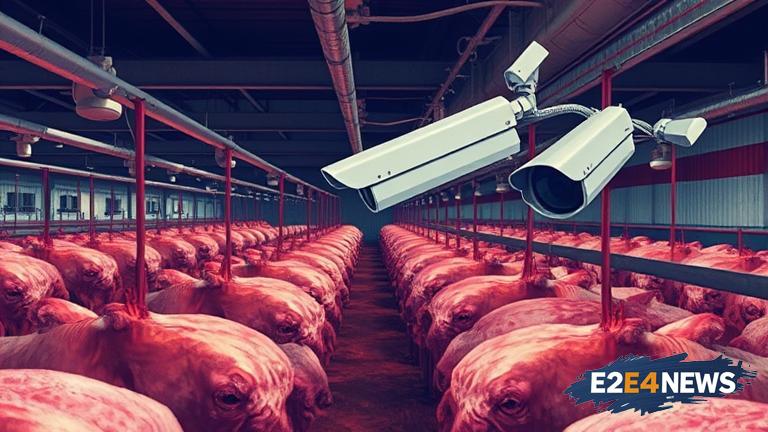The Chamber of Commerce and Industry of Kashmir (CCIK) has recently made a pressing appeal to the government, emphasizing the need to install CCTV cameras at all slaughterhouses operating within the region. This move is aimed at promoting transparency, ensuring the humane treatment of animals, and maintaining the overall quality of meat products. By installing CCTV cameras, the authorities can effectively monitor the activities taking place within these facilities, thereby preventing any potential misuse or cruelty towards animals. The CCIK believes that this initiative will not only safeguard animal welfare but also contribute to the improvement of the meat industry as a whole. Furthermore, the installation of CCTV cameras will enable the government to keep a close eye on the slaughterhouses, ensuring that they adhere to the prescribed norms and regulations. This, in turn, will help in preventing the spread of diseases and maintaining public health. The CCIK has also highlighted the importance of regular inspections and audits at these facilities to guarantee compliance with the set standards. In addition to this, the organization has suggested that the government should establish a mechanism for receiving and addressing public complaints regarding the functioning of slaughterhouses. The CCIK is of the view that the implementation of such measures will foster a sense of trust among consumers, ultimately benefiting the meat industry. The proposal has been welcomed by various stakeholders, including animal welfare organizations and consumer rights groups. These groups have been advocating for improved conditions at slaughterhouses, citing concerns over animal cruelty and the potential health risks associated with the consumption of poorly processed meat. The government has been urged to take immediate action on the CCIK’s proposal, ensuring that the installation of CCTV cameras is carried out in a phased manner, starting with the largest slaughterhouses. Moreover, the authorities have been advised to ensure that the footage recorded by these cameras is regularly monitored and analyzed, with any discrepancies or violations being promptly addressed. The CCIK has assured its full cooperation in this endeavor, offering to work closely with the government to achieve the desired outcomes. The organization has also expressed its willingness to provide technical assistance and support, wherever required, to facilitate the smooth implementation of this project. In conclusion, the CCIK’s proposal to install CCTV cameras at slaughterhouses is a significant step towards promoting transparency, accountability, and animal welfare in the meat industry. The government’s response to this proposal will be closely watched, as it has the potential to bring about a substantial improvement in the overall functioning of slaughterhouses, ultimately benefiting both consumers and the industry as a whole. The CCIK’s initiative has sparked a renewed debate on the need for stricter regulations and improved monitoring mechanisms at slaughterhouses, with many experts and stakeholders weighing in on the issue. As the discussion unfolds, it is becoming increasingly clear that the installation of CCTV cameras is just the first step towards achieving a more humane and regulated meat industry. The road ahead will require sustained efforts from all stakeholders, including the government, industry players, and civil society organizations, to create a system that prioritizes animal welfare, public health, and consumer trust. With the CCIK’s proposal gaining traction, it is hoped that the government will take decisive action, paving the way for a more transparent and accountable meat industry in the region. The success of this initiative will depend on the collective efforts of all stakeholders, and it is imperative that they work together to achieve the desired outcomes. The CCIK’s call for action has highlighted the need for a collaborative approach, one that brings together the government, industry players, and civil society organizations to address the complex challenges facing the meat industry. By working together, it is possible to create a system that balances the needs of all stakeholders, while prioritizing animal welfare, public health, and consumer trust. The installation of CCTV cameras at slaughterhouses is a crucial step in this direction, and it is hoped that the government will take immediate action to implement this measure. The CCIK’s proposal has the potential to bring about a significant improvement in the meat industry, and it is imperative that all stakeholders work together to achieve this goal. The government’s response to this proposal will be closely watched, and it is hoped that they will take decisive action to address the concerns raised by the CCIK. The success of this initiative will depend on the collective efforts of all stakeholders, and it is essential that they work together to create a more transparent and accountable meat industry. The CCIK’s call for action has sparked a renewed debate on the need for stricter regulations and improved monitoring mechanisms at slaughterhouses, and it is hoped that this will lead to a more humane and regulated meat industry. The road ahead will require sustained efforts from all stakeholders, but the potential benefits of this initiative make it an endeavor worth pursuing. The CCIK’s proposal is a significant step towards promoting transparency, accountability, and animal welfare in the meat industry, and it is hoped that the government will take immediate action to implement this measure. The installation of CCTV cameras at slaughterhouses is just the first step towards achieving a more humane and regulated meat industry, and it is essential that all stakeholders work together to create a system that prioritizes animal welfare, public health, and consumer trust.
